Share this
Planning for corrective jaw surgery for underbite deformity
on June 22, 2016
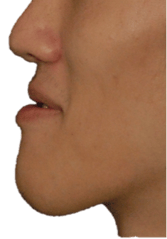 Underbite deformity in Singapore is the most commonly correct dentofacial deformity. With advances in understanding of the healing process and orthodontic movement of teeth, it is usually treated in a surgery-first approach today. This is in contrast with the old practice of going through a year or two of pre-surgical orthodontics to prepare the teeth for surgery. The use of CT scans and 3D modeling software enable both surgeon and patient to visualize the facial aesthetic treatment outcome that is desired. Let’s take a look at a typical case of surgical correction of an underbite deformity.
Underbite deformity in Singapore is the most commonly correct dentofacial deformity. With advances in understanding of the healing process and orthodontic movement of teeth, it is usually treated in a surgery-first approach today. This is in contrast with the old practice of going through a year or two of pre-surgical orthodontics to prepare the teeth for surgery. The use of CT scans and 3D modeling software enable both surgeon and patient to visualize the facial aesthetic treatment outcome that is desired. Let’s take a look at a typical case of surgical correction of an underbite deformity.
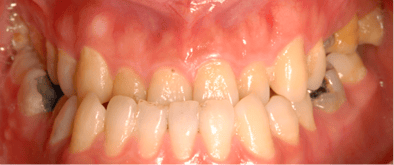 A 25 year old male complained of a long protruding lower jaw and requested for orthognathic surgery to correct it. Physical examination showed that the face was long both vertically and horizontally. In addition, the midface was flat, giving the face a concave profile. Intraorally, the teeth were crowded and poorly aligned.
A 25 year old male complained of a long protruding lower jaw and requested for orthognathic surgery to correct it. Physical examination showed that the face was long both vertically and horizontally. In addition, the midface was flat, giving the face a concave profile. Intraorally, the teeth were crowded and poorly aligned.
A CT scan was done and analysis of the facial skeletal structures and proportions was done. Using a specialized software, the CT data was used to generate a 3D model of his facial bones, separating the upper jaw, the lower and the rest of the skull. A soft tissue model was also generated.
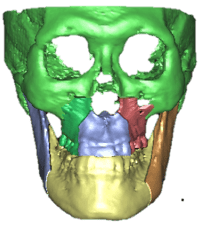
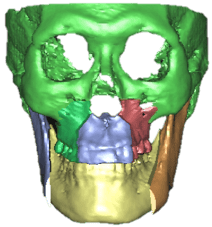
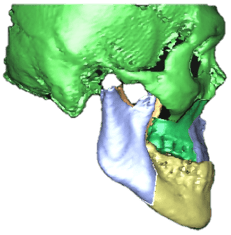
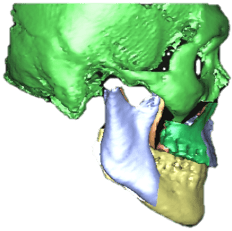
Based on the diagnosis of a long face with protruding lower jaw and depressed midface, a treatment plan was formulated. This consisted of a Le Fort I osteotomy to advance the upper jaw and a bilateral sagittal split to set the lower jaw back. To determine the amount of movement of each jaw, the surgery was simulated on the computer using the software. Within the program, the jaws was moved by different distances and in different directions and the resultant changes in facial appearance would be simulated.
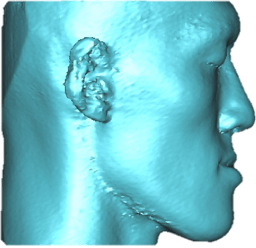
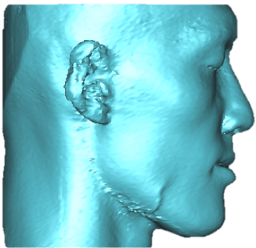
Other than being a useful planning tool, this simulation process is a very important communication tool between the surgeon and the patient. While the functional aspects of corrective jaw surgery is based on certain well established principles of how the teeth should meet, the aesthetic aspect is very subjective. Sometimes, what the patient has in mind may not be the same as the surgeon and both are none the wiser about it. Having a simulation tool enables calibration of the aesthetic demands and preferences between surgeon and patient.
Once the plan was finalized, the surgical plan was simulated once more on stone models of the jaws before actually doing the surgery itself. This patient underwent a four hour operation and stayed in the hospital for three days postoperatively. One month after the surgery, orthodontic treatment was started.
Share this
- Jaw Surgery (93)
- Dental Implants Singapore (90)
- Orthognathic Surgery (48)
- Replacing Missing Teeth (26)
- Missing Teeth Options (23)
- Underbite (23)
- Bone Grafting (21)
- Costs (18)
- Facial Aesthetics (18)
- Aesthetics (17)
- dental implants (16)
- corrective jaw surgery (15)
- BOTOX (11)
- Dermal Fillers (11)
- Wisdom teeth (10)
- Fixed Implant Dentures (8)
- Loose Dentures Singapore (6)
- Medisave (6)
- sleep apnea (6)
- Braces (5)
- Dental Pain (5)
- Dentures in Singapore (5)
- Loose Teeth (5)
- Tooth Extraction (5)
- jaw deformities (5)
- bimax (4)
- bone graft (4)
- maxillomandibular advancement (4)
- all-on-4 (3)
- bimaxillary protrusion (3)
- chin implant (3)
- facial asymmetry (3)
- full mouth dental implants (3)
- genioplasty (3)
- immediate implant (3)
- removal of an integrated dental implant (3)
- third molars (3)
- wisdom tooth surgery (3)
- My Dentures Don't Fit (2)
- VME (2)
- bone graft healing (2)
- distraction osteogenesis (2)
- medical tourism (2)
- obstructive sleep apnea (2)
- orthodontics (2)
- plastic surgery (2)
- CT guided dental implants (1)
- Double jaw surgery (1)
- Invisalign (1)
- Periodontal Disease (1)
- Permanent Dentures Singapore (1)
- before and after photos (1)
- facial trauma (1)
- fractured dental implant (1)
- oral appliance therapy (1)
- root canal treatment (1)
- veneers (1)
- vertical maxillary excess (1)
- September 2019 (2)
- July 2019 (2)
- May 2019 (2)
- August 2018 (1)
- October 2017 (1)
- September 2017 (2)
- August 2017 (1)
- June 2017 (2)
- May 2017 (4)
- April 2017 (1)
- March 2017 (1)
- February 2017 (3)
- January 2017 (3)
- December 2016 (1)
- November 2016 (2)
- October 2016 (4)
- September 2016 (9)
- August 2016 (5)
- July 2016 (11)
- June 2016 (14)
- May 2016 (6)
- April 2016 (2)
- March 2016 (1)
- January 2016 (7)
- December 2015 (10)
- November 2015 (4)
- October 2015 (9)
- September 2015 (7)
- August 2015 (1)
- July 2015 (6)
- June 2015 (3)
- May 2015 (7)
- April 2015 (5)
- March 2015 (8)
- January 2015 (5)
- December 2014 (7)
- November 2014 (7)
- October 2014 (6)
- September 2014 (8)
- August 2014 (5)
- July 2014 (7)
- June 2014 (8)
- May 2014 (9)
- April 2014 (10)
- March 2014 (6)
- February 2014 (8)
- January 2014 (3)
Subscribe by email
Email subscription




No Comments Yet
Let us know what you think